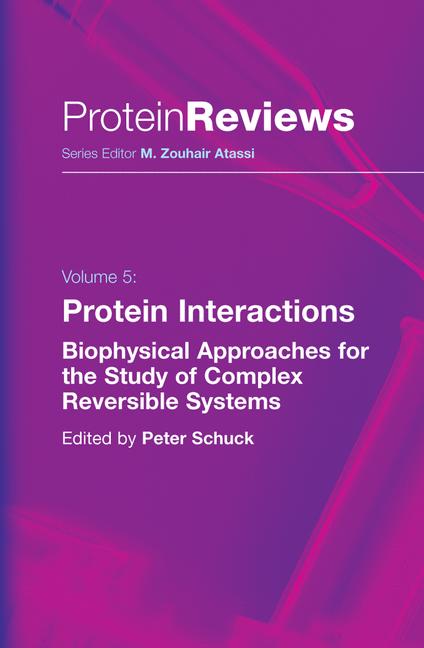(To see other currencies, click on price)
MORE ABOUT THIS BOOK
Main description:
When I was invited to edit this volume, I wanted to take the opportunity to assemble reviews of different biophysical methodologies for protein interactions at a level suf?ciently detailed to understand how complex systems can be studied. There are several excellent introductory texts for biophysical methodologies, many with hands-on descriptions or embedded in general introductions to physical b- chemistry. The goal of the present volume was to present state-of-the-art reviews that do not necessarily enable the reader to carry out these techniques, but to gain a deep understanding of the biophysical observables, to stimulate creative thought on how the techniques may be applied to study a particular biological system, and to foster collaboration and multidisciplinary work. Reversible protein interactions involve noncovalent chemical bonds, pro- cing protein complexes with free energies not far from the order of magnitude of the thermal energy kT. As a consequence, they can be highly dynamic and may be controlled, for example, by protein expression levels and changes in the intracel- lar or microenvironment. Reversible protein complexes may have suf?cient stab- ity to be puri?ed for study, but frequently their short lifetime essentially limits their existence to solutions of mixtures of the binding partners in which they remain populated through dissociation and reassociation processes. To understand the function of such protein complexes, it is important to study their structure and dynamics.
Feature:
Examines how biophysical approaches can be used to study complex systems of reversibly interacting proteins and shows how to synergistically incorporate several methodologies for use
Covers calorimetry, fluorescence, surface plasmon resonance, evanescent wave biosensors, mass spectroscopy, electrophoretic mobility, FRET, H-D exchange methods, solvent-mediated protein interactions, and other methodologies
Explores interacting protein partners, binding protein, protein modifications, protein analysis, complex protein systems, and other protein interactions
Is part of the Protein Reviews series
Back cover:
This comprehensive volume, written by experts in the field, brings together a coherent set of reviews of different biophysical methodologies for the study of reversible protein interactions. These reviews allow the reader to gain a deep understanding of the biophysical observables, to stimulate creative thought on how the techniques may be applied to study a particular biological system, and to foster collaboration and multi-disciplinary work. The side-by-side presentation of different approaches highlights aspects they have in common, as well as orthogonal viewpoints that may provide opportunities for synergistic combination. Protein Interactions is an ideal book for biochemists, protein scientists, bioenginners, and molecular and cellular biologists.
Contents:
The Characterization of Biomolecular Interactions Using Fluorescence Fluctuation Techniques.- Characterization of Protein–Protein Interactions Using Atomic Force Microscopy.- Combined Solid-Phase Detection Techniques for Dissecting Multiprotein Interactions on Membranes.- Surface Plasmon Resonance Biosensing in the Study of Ternary Systems of Interacting Proteins.- Mass Spectrometry for Studying Protein Modifications and for Discovery of Protein Interactions.- H/2H Exchange Mass Spectrometry of Protein Complexes.- Elucidation of Protein–Protein and Protein–Ligand Interactions by NMR Spectroscopy.- Application of Isothermal Titration Calorimetry in Exploring the Extended Interface.- Solvent Mediated Protein–Protein Interactions.- Sedimentation Equilibrium Analytical Ultracentrifugation for Multicomponent Protein Interactions.- Structure Analysis of Macromolecular Complexes by Solution Small-Angle Scattering.- Fluorescence Detection of Proximity.- Steady-State and Time-Resolved Emission Anisotropy.- Analysis of Protein-DNA Equilibria by Native Gel Electrophoresis.- Electrospray Ionization Mass Spectrometry and the Study of Protein Complexes.- Sedimentation Velocity in the Study of Reversible Multiprotein Complexes.
PRODUCT DETAILS
Publisher: Springer (Springer US)
Publication date: April, 2007
Pages: 532
Weight: 1211g
Availability: Not available (reason unspecified)
Subcategories: Biochemistry
Publisher recommends
From the same series


























